Topic: How to enable and manage version control
Description: Learn how to configure and manage the Version Control settings of a List or Library.
Table of contents:
1.Changing Version Control
2.Viewing Version Control Information
3.How to View, Restore, or Delete an earlier version
When versioning is enabled in your SharePoint List or Library, you can store, track, and restore items in a list and files in a library whenever they change. Versioning, combined with other settings, such as checkout, gives you a lot of control of the content that is posted on your site and can provide real value if you ever have a need to look at or restore an old version of an item or file.
Navigate to the required List or Library.

From the Ribbon Menu, select the Library tab and then Library Settings (Note: if this is a List, select the List tab and then List Settings)

The List Information screen will appear, click on Versioning settings.
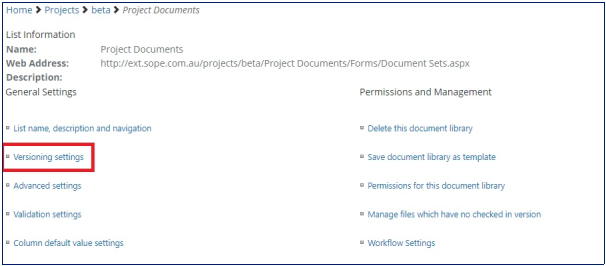
There are a number of settings that you can change:
Content Approval

Lists and Libraries can often contain sensitive information. It can be important to have only “official” versions of items or files viewable by users. To do this you can require approval of an item or file before the content becomes visible to most site users. By requiring approval, the organisation can apply a significant level of quality and security to the content in the lists and libraries.
The default value is No, select the Yes radio button to enable Content Approval.
Version History
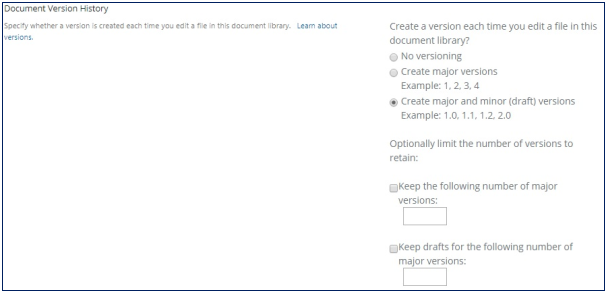
When versioning is enabled in your SharePoint List or Library, you can store, track, and restore items in a list and files in a library whenever they change. Versioning, combined with other settings, such as checkout, gives you a lot of control of the content that is posted on your site and can provide real value if you ever have a need to look at or restore an old version of an item or file.
NOTE: Versioning is on by default in SharePoint Libraries, and off by default in SharePoint Lists.
Anyone with permission to manage Lists can turn versioning on or off for a Library. Versioning is available for list items in all default list types—including calendars, issue tracking lists, and custom lists. It is also available for all file types that can be stored in libraries, including Web Part pages.
You can use versioning to:
- Track history of a version When versioning is enabled, you can see when an item or file was changed and who changed it. You can also see when properties (information about the file) were changed. For example, if someone changes the due date of a list item, that information appears in the version history. You can also see the comments people make when they check files into libraries.
- Restore a previous version If you made a mistake in a current version, if the current version is corrupt, or if you simply like a previous version better, you can replace the current version with a previous one. The restored version becomes the new current version.
- View a previous version You can view a previous version without overwriting your current version. If you are viewing version history within a Microsoft Office document, such as a Word or Excel file, you can compare the two versions to determine what the differences are.
When versioning is enabled, versions are created in the following situations:
- When a list item or file is first created or when a file is uploaded.
- When the properties of a list item or file are changed.
- When a file is opened, edited, and saved. A version is created when you first click Save. It retains the new version number for the duration of the current editing session, even though you might save it several times. When you close it and then reopen it for another editing session, another version is created.
Major and Minor versions
Some organisations track both major and minor versions of files in their libraries. Others only track the major versions. Major versions are identified by whole numbers, such as 5.0; minor versions are identified by decimal numbers, such as 5.1.
Use minor versions when files are under development, and major versions when certain milestones are reached or when the files are ready for review by a wide audience. In many organizations, draft security is set to allow only the owner of a file and people who have permissions to approve files. That means that minor versions cannot be seen by anyone else until a major version is published.
Major versions are available for lists, but minor versions are not available. Each version of a list item is numbered with a whole number. If your organisation requires approval of items in a list, the items remain in Pending status until they are approved by someone who has permissions to approve them. While in Pending status they are numbered with decimal numbers and are referred to as drafts.
Version Numbering
Version numbers are automatically added each time you create a new version. In a List or Library that has major versioning enabled, the versions have whole numbers, such as 1.0, 2.0, 3.0, and so on. In Libraries, your administrator might enable versioning for both major and minor versions. When minor versions are being tracked, they have decimal numbers such as 1.1, 1.2, 1.3, and so on. When one of those versions is published as a major version, its number becomes 2.0. Subsequent minor versions are numbered 2.1, 2.2, 2.3, and so on.
When you discard a checkout, the version number does not change. If the most recent version was version 3.0, it remains at 3.0 after you discard the checkout.
Draft Item Security
It can be important to have only “official” versions of items or files viewable by users. To do this you can require approval of an item or file before the content becomes visible to most site users. By requiring approval, the organisation can apply a significant level of quality and security to the content in the lists and libraries.

You can choose any of the following options:
- Users who can read items in the list
- Only users who can edit items in the list
- Only users who can approve items in the list, and the item author
Require Check Out
One way to control document collaboration is to require check-out of files, especially when multiple users have access to the library. If a library checkout is required, other people cannot overwrite it. However, you run the risk of preventing other people from seeing the latest changes or making changes themselves. If others need to work on the document it is important that files are checked back in quickly.

To view the Version History, select an item in the List or Library and from the Ribbon menu, select Files, Version History.
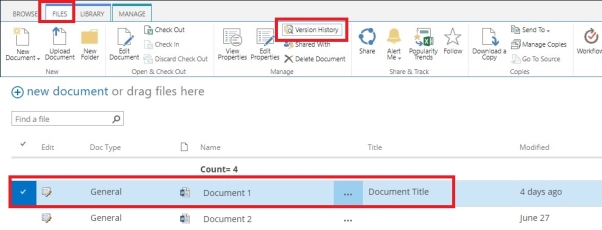
The Version History screen will pop-up:
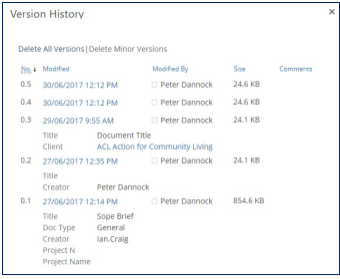
When you're done, click the X in the upper right corner to close the dialog.
Go to the List or Library with the item or document for which you want to view history.
To view the Version History, select an item in the List or Library and from the Ribbon menu, select Files, Version History.

The file tab with Version History highlighted
In the Version History dialog box, hover your mouse over the date link on an earlier version and click the down arrow to show the menu.
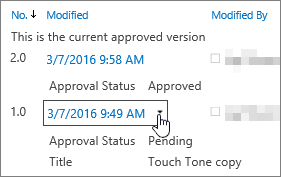
Version dropdown dialog button
In the menu, you can do the following.
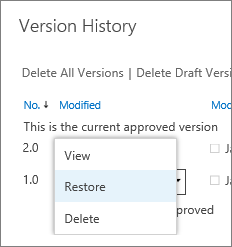
- View the current document - this option will bring up a dialog where you can edit, restore, or delete, as well as see the current approval status.
- Restore the document - this option displays a dialog asking if you want to make it the currently approved document. It will add it as a new version.
- Delete the document - this option displays a dialog asking if you're sure you want to send the item to the Recycle Bin.
- Reject this version - this only shows up on approved documents, rather than Delete.
When you're done, click the X in the upper right corner to close the dialog.